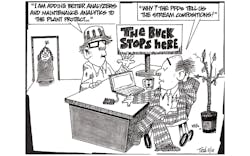This Control Talk column appeared in the March 2021 print edition of Control. To read more Control Talk columns click here or read the Control Talk blog here.
Greg: Process compositions are generally the most important process variables in terms of revealing the sources of variability and what is truly going on in the process, leading to improvement opportunities in quality and yield. In many cases, analyzers are not used as extensively as needed because of lack of confidence and appreciation of the incredible spectrum of opportunities offered by good composition measurements. Joining me to help us make great strides forward in getting the most out of our analyzers for process control improvement via digital transformation and big data is Ryan Simpson, process analytics engineer at Eastman Chemical, who has made great progress in the use of data analytics as well as OSIsoft’s PI Vision and Asset Framework tools for analytical measurements.
How can we detect and alert operations and maintenance more easily to invalid or frozen analytical measurements with these new software tools?
Ryan: For decades now, analyzers have been connected to distributed control systems (DCSs) and historians. However, we have been limited in our ability to customize how we alarm on these systems outside of these historical platforms such as the DCS consoles or historian alarm client. Now, there are many web-based tools available such as PI Vision and Microsoft Power BI which can be more easily owned and programmed by the engineer or technician to alarm on custom logic such as a standard deviation or change in signal state of the analyzer. Easily customizable emails can be configured for high priority problems that include information from the analyzer in the body of the email and may even link to a troubleshooting workflow, etc. Analyzer information is now more accessible by the appropriate teams than ever!
Greg: How can we improve analyzer calibration methodology and frequency?
Ryan: When responsible for large numbers of analyzers, such as is the case for Eastman’s Process Analytics team, it’s important to be as efficient as possible with the resources you have. Mistakes in calibration methodology and non-optimal benchmark frequencies only lead to team inefficiencies. We have recently completed a project to reevaluate our validation and calibration frequencies of highly reliable analyzers such as for continuous gas analysis (CGAs) and toxic gas measurement. These instruments have improved their reliability over the last 30 years and no longer need calibrating as frequently as they once did. We are also investigating the use of digital workflows on mobile devices that will enable automated, more accurate and efficient validation of these instruments.
Greg: Can we automatically detect if a sensor needs to be replaced or needs maintenance?
Ryan: Many of the newer instruments on the market offer output of sensor/detector data through to the DCS. We have worked with several vendors on this issue to ensure key performance indicators such as sensor voltage, signal amplitude, amperage, temperature, etc. can be output through a Modbus or other fieldbus connection. These signals can then be monitored and alerted on if too much drift has occurred. This has saved us on several occasions before the next scheduled preventive maintenance check.
Greg: Can we develop and improve inferential measurements of compositions?
Ryan: I feel like this is an area of great progress lately, with many companies offering multivariate or machine-learning platforms. In legacy chemical companies it can sometimes be harder to make the leap to “black box” control just due to the established legacy of pressure, temperature, and flow-based control. However, I have seen this start to take off within our own company and am very excited about the possibilities of looking at all of a process’s many measured variables at once and using advanced algorithms such as principal component analysis (PCA) to determine “are we where we should be?” with the process. I believe progress in advanced inferential control will be one of the greatest return on investments in the near future for the chemicals industry as a whole.
Greg: The use of PCA and partial-least-squares or projection-to-latent-structure models is better than neural network models because of the linear interpolation, extrapolation and elimination of cross correlations. This is particularly important due to loop tuning, interactions, and a deficiency in diversity of operating points and process conditions because of the need to maintain process control. However, there still remains the need for dynamic compensation of each input for continuous processes that is challenging due the large and variable dead times and time constants that are a function of production rate and recycle. First-principle models can help with verifying causes and effects and filling in the blanks so far as the effect of operating conditions. Fortunately, dynamic compensation is not needed for batch processes, which translates to an effective use of data analytics to predict batch profiles and end points. For a perspective and understanding of the opportunities see the Control article “At the IIoT crossroads”.
Can we increase the use of analyzers for closed loop control and optimization?
Ryan: I continue to see many opportunities within Eastman for use of faster advanced spectroscopic instrumentation such as infrared (IR), near infrared (NIR) and Raman that utilize partial-least-squares (PLS) or PCA models. The speed of these analysis techniques coupled with their measurement precision presents a large value across the board to replace lab measurements and older gas chromatography applications which may be too slow or noisy for the process dynamics to be used in a closed control loop.
Greg: Can we track down the sources of variability including upstream and recycle compositions with continuous process composition measurements?
Ryan: Certainly, I have seen several instances where once continuous composition measurements in a stream were enabled, questions are suddenly answered and suspicions either confirmed or disproved. In many chemical processes, extensive assumptions are made regarding density, losses to atmosphere, raw material concentrations, efficiency, etc. You also assume the existing instrumentation is correct and providing engineers the right numbers for those complicated, Excel-based mass balance calculations that we are all too familiar with. Having accurate and fast composition measurements in a process becomes essential at a point to close mass balances and provide further process improvement opportunities.
Greg: What do you think is the biggest opportunity for process instrumentation engineers to use the digital transformation tools now available?
Ryan: I believe that maintenance and reliability of process instrumentation is about to forever be changed. The digital tools that will become available in the field at the point of use will be transformational and allow for automated calibration data transfer to the DCS or enterprise platforms. Digital procedures will walk technicians through calibration and troubleshooting aided by remote support platforms such as Microsoft Teams and RealWear. This will only serve to increase the reliability and uptime of process instrumentation. Quick and easy browser-based reporting via Power BI connected to instrumentation databases will also allow for increased visibility of analyzer issues from the ground floor to upper management and allow for improved determination of needed priorities.
Greg: What do you think is the biggest hurdle in the way forward for digital transformation in the process analyzer space?
Ryan: I think the support and resources required from the IT side to effectively implement these tools is underestimated. Many companies want to leap into this space but fail to make the investment in IT they need—both upfront and long term. Engineers are effective at many things and can wear many hats, but IT data security and database connectivity is sometimes such a niche; it takes a devoted team to connect process data safely to cloud-based services. It can also take a lot of time for the initial install and setup of these systems, consuming a large amount of time from engineers that are already stretched thin. To effectively implement these next-generation platforms, companies must be willing to invest the right amount of money to generate the returns, otherwise they are asking for project failure.
10. Operators have their favorite setpoints
9. It is anybody’s guess what the process is really doing
8. Lab samples are few and far between sometimes
7. Lab samples are shipped to an undisclosed remote lab to save money
6. Lab samples are found sitting on a lab bench waiting for gases to evolve
5. Lab samples are found sitting on a lab bench waiting for solids to settle
4. Time lab samples taken from process not known
3. Lab sample temperature not the same as process temperature during lab analysis
2. Lab samples are combined to smooth out the data and reduce lab work
1. Process stream compositions are thought to be what is on process flow diagrams (PFDs)






